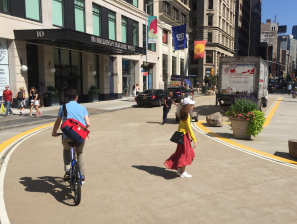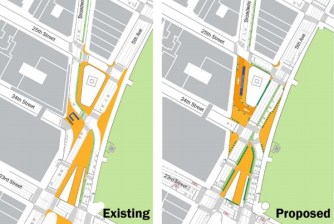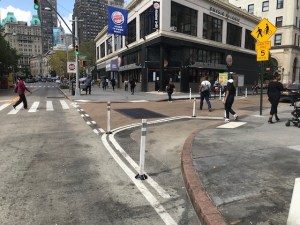OPINION: Expand the Shared Street at University Place in Manhattan
A one-block experiment south of Union Square has more than proved its worth. In fact, it's a model for the city.

Almost two years ago, the Department of Transportation announced that, as an experiment, it would convert the northernmost block of University Place, between 13th and 14th street, into a one-block shared street.

The DOT is now considering whether to expand this pilot, and replicate it across the city, with improvements based on what it learned from the experiment. The treatment could be expanded to the rest of University Place, creating a boulevard for people that connects Union Square to Washington Square. As a resident of the area, I say, “Yes, please!”
I first visited the reimagined block shortly after it opened, and as a person who’s usually on foot or two wheels, I now find myself there regularly, because it’s safer and more pleasant than it was before. It’s directly across from Union Square and adjacent to the 14th Street busway, so it’s effectively an extension of existing people space, and it’s close to the crosstown bike routes on 12th and 13th streets.
The DOT has provided bike locking loops, and some places to sit. The paved surface is recognizable by everyone as pedestrian space. Chicanes (physically demarcated sharp turns) keep drivers moving slowly. Curbside parking is gone. And the nearby traffic pattern has been changed, so that the block is no longer part of a through route, further discouraging drivers.
We know that extending this street treatment down University Place will work because it’s already happened, albeit part-time and provisionally: The remaining seven blocks of University Place are now part of the DOT’s Open Streets program one day a week, and that street space will be intensively used by people on foot and bike now that spring weather is here. But the DOT should have done the whole street 18 months ago when it did that first block.
This has already been adjudicated: the feedback they need is already in the community board resolution from 18 months ago, which asked for 10 blocks of this and the DOT gave them one block https://t.co/Kat16ZdDQL
— Rich Mintz (@richmintz) March 12, 2021
The community boards in Manhattan are, on the whole, very supportive of reimagining street space in ways that reduce vehicular traffic. (The board on which I sit, Manhattan Community Board 6, strongly supported the 14th Street busway and pedestrian improvements, voting in favor of them twice). Manhattan CB2 (which represents the area immediately south of Union Square) is no exception. When the DOT approached CB2 in 2019 to discuss its plans, the board resolved (by a vote of 38-1), “CB2’s very first choice would be a greenway on University Place from 14th Street to W. Fourth Street, where it would connect with Washington Square Park.”

Every part of the city deserves genuine people-first street space, and there are streets like University Place in every borough: relatively low-traffic, short, non-connecting roadways with intensive human traffic that are adjacent to transit, with parallel vehicular alternative routes that can easily absorb rerouted cars and trucks. This design is a good compromise between “do nothing” and “close the street to cars entirely”; there’s nothing impeding passenger loading or business service traffic when it’s necessary, but casual traffic volume drops markedly, often by 75 percent. There are things I’d change (more benches! water fountains! permanent plantings!), but the general model works beautifully.
And on University Place, where the neighborhood asked for a full conversion, we should have one. Let’s turn University Place from 14th Street to Washington Square into an extended demonstration to all in the city that people-first street space is a sustainable and successful choice that deserves to be extended across the city.
Rich Mintz is a street-safety advocate and a member of Manhattan Community Board 6, which covers Manhattan’s East Side from 14th to 59th streets. Follow him on Twitter @richmintz.



